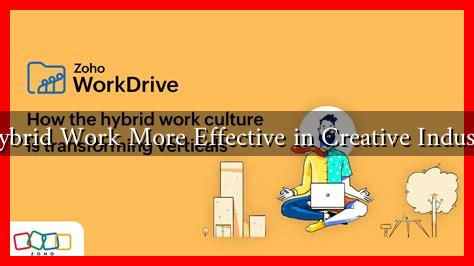-
Table of Contents
- Is Hybrid Work More Effective in Creative Industries?
- The Hybrid Work Model Explained
- Advantages of Hybrid Work in Creative Industries
- Challenges of Hybrid Work in Creative Industries
- Case Studies: Success Stories in Hybrid Creative Work
- Statistics Supporting Hybrid Work in Creative Industries
- Conclusion: The Future of Hybrid Work in Creative Industries
Is Hybrid Work More Effective in Creative Industries?
The rise of hybrid work models has transformed the landscape of various industries, particularly in creative sectors such as advertising, design, and media. As organizations adapt to this new normal, the question arises: is hybrid work more effective in creative industries? This article explores the advantages and challenges of hybrid work in creative fields, supported by case studies, statistics, and expert opinions.
The Hybrid Work Model Explained
Hybrid work combines remote and in-office work, allowing employees to choose where they work based on their tasks and preferences. This model has gained traction due to advancements in technology and changing employee expectations. According to a survey by McKinsey, 58% of employees in the U.S. can work remotely at least one day a week, and 35% can do so full-time.
Advantages of Hybrid Work in Creative Industries
Creative industries thrive on innovation, collaboration, and flexibility. The hybrid work model offers several advantages that can enhance productivity and creativity:
- Flexibility: Employees can choose their work environment, which can lead to increased job satisfaction and motivation. A study by Buffer found that 32% of remote workers cite flexibility as the biggest benefit of remote work.
- Access to a Broader Talent Pool: Companies can hire talent from anywhere, not limited by geographical constraints. This diversity can lead to richer ideas and perspectives.
- Improved Work-Life Balance: Hybrid work allows employees to better manage their personal and professional lives, reducing burnout and increasing overall well-being.
- Enhanced Collaboration Tools: With the rise of digital collaboration tools like Slack, Zoom, and Miro, teams can communicate and brainstorm effectively, regardless of their physical location.
Challenges of Hybrid Work in Creative Industries
While hybrid work offers numerous benefits, it also presents challenges that can impact creativity and collaboration:
- Communication Barriers: Remote work can lead to misunderstandings and a lack of spontaneous conversations that often spark creativity. A study by Harvard Business Review found that remote teams can struggle with communication, leading to decreased collaboration.
- Isolation: Creative professionals often thrive on social interactions. Working remotely can lead to feelings of isolation, which may stifle creativity.
- Inconsistent Company Culture: Maintaining a cohesive company culture can be challenging in a hybrid model. Employees may feel disconnected from the organization’s values and mission.
Case Studies: Success Stories in Hybrid Creative Work
Several companies in the creative sector have successfully implemented hybrid work models, showcasing the potential for effectiveness:
- Adobe: The software giant adopted a hybrid model that allows employees to work from home or the office. This flexibility has led to increased employee satisfaction and retention rates, with 80% of employees reporting higher productivity levels.
- Frog Design: This global design firm has embraced hybrid work, allowing teams to collaborate across different locations. Their approach has resulted in innovative projects and a diverse range of ideas, enhancing their creative output.
Statistics Supporting Hybrid Work in Creative Industries
Several studies highlight the effectiveness of hybrid work in creative industries:
- A report by Gartner found that 47% of organizations plan to allow employees to work remotely full-time, indicating a shift towards hybrid models.
- According to a survey by PwC, 83% of employers believe that the shift to remote work has been successful for their companies, particularly in creative sectors.
Conclusion: The Future of Hybrid Work in Creative Industries
In conclusion, hybrid work presents both opportunities and challenges for creative industries. While it offers flexibility, access to diverse talent, and improved work-life balance, it also requires careful management of communication and company culture. As organizations continue to navigate this new landscape, the key to success lies in leveraging technology, fostering collaboration, and prioritizing employee well-being. The future of work in creative industries may very well be hybrid, blending the best of both worlds to drive innovation and creativity.
For more insights on hybrid work and its impact on various industries, visit McKinsey & Company.


